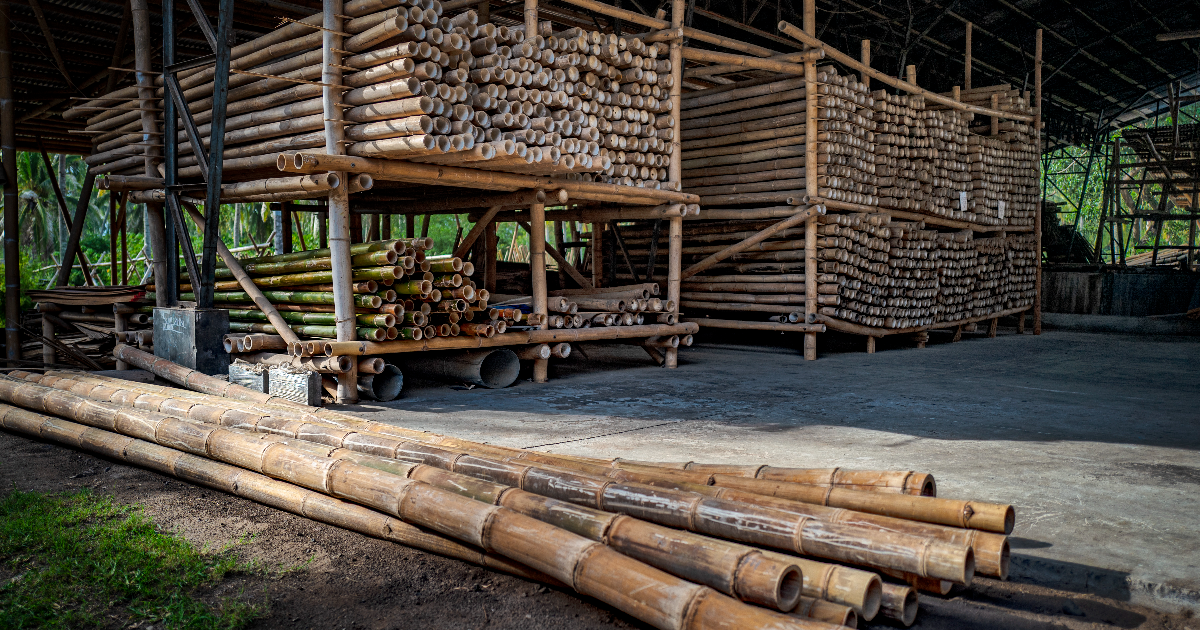
From Harvesting to Building: Making High-quality Building Materials with Bamboo
Building with bamboo offers a unique opportunity to create sustainable, affordable, and beautiful structures. However, it’s important to note that bamboo, like any other material, requires proper treatment to ensure its durability and longevity in construction projects.
One of the main reasons to treat bamboo is to stop it from rotting and attracting bugs which can lead to fungus growth and weaken the material. Also, insects like termites, beetles, and borers can live in bamboo, damaging the building’s structure. There are several methods for treating bamboo, and the choice of method depends on the intended use and the specific environmental conditions of the construction site. Let’s explore some of the common methods for treating bamboo poles.
Harvesting High Quality Bamboo
Selecting construction grade bamboo for construction involves several key considerations:
- Species of bamboo: There are many species of bamboo, and not all of them are suitable for construction. Look for bamboo species that are known for their strength and durability, such as Guadua Angustifolia, Bambusa Blumeana, and Dentrocalamus Asper.
- Age of bamboo: When fully mature, bamboo reaches its peak strength and durability, typically between 3 and 5 years of age, depending on the species. Avoid using bamboo that is less than three years old for construction purposes, as it may lack the necessary strength.
- Straightness: Look for upright bamboo culms with minimal bending or warping. Bent or deformed bamboo culms may compromise the structural integrity of the structure and make installation challenging.
- Visual inspection: Inspect the bamboo culms visually for any visible defects such as cracks, holes, or signs of damage. Avoid using bamboo with visible defects as they may compromise its strength and durability.
Considering these factors, you can choose bamboo that is durable and suited to your particular needs.
Soaking
In Asia, soaking bamboo poles in salt water is a common traditional method of preservation. This process is similar to pickling, as it removes sugars from the bamboo, preserves it, and makes it less appealing to pests. Soaking of bamboo is a common practice that serves to prepare bamboo for a variety of applications, including construction, furniture making, and arts and crafts. Base simulates this process by soaking the bamboo in a multi-layer washing tub with running water to drain the starch out of the bamboo.
Drying
After soaking, bamboo is typically dried by resting it against another bamboo tree or structure. This allows for natural ventilation to aid in the gradual reduction of moisture and humidity in the bamboo. Monitoring the drying process is essential for achieving uniform drying and preventing mold growth. When bamboo is properly dried, it becomes less vulnerable to rot and insect infestation.
Treatment
Bamboo preservation is crucial to maintaining its longevity and sustainability. The durability of bamboo is influenced by its exposure position and the rate of attack by biological agents. Untreated bamboo exposed to soil and atmosphere has a short lifespan, while treated bamboo’s lifespan increases life expectancy to 50-100 years.
Preserving bamboo can be challenging due to its unique structure, with the outer skin and waxy layer making it difficult to apply preservatives. Various treatment methods have been developed to overcome these challenges, including prophylactic, non-pressure, and pressure treatments. Choosing the right preservative chemicals approved by the Fertilizer and Pesticide Authority (FPA), boron, borax, boric acid, and phytochemicals, are popular. By preserving bamboo, we can ensure its sustainability and promote its use as an eco-friendly and long-lasting material.
Producing high-quality bamboo materials for construction demands dedication and expertise. Base Bahay, a recognized expert in cement-bamboo frame housing, can play a crucial role in advancing innovative techniques that establish bamboo as a viable option for construction materials. Together, we can contribute to a greener and more sustainable future.
Base Bahay Foundation, Inc (BASE) is the pioneer of Cement-Bamboo Framework in the Philippines. BASE builds affordable and disaster-resilient structures using bamboo-based technology. Through continuous research in the Base Innovation Center (BIC), BASE is optimizing the technology and looking for new applications outside its standard model. BASE also offers training courses under its Bamboo Academy program to share the alternative building technologies and provide further knowledge on bamboo construction. Learn more about BASE initiatives and join the movement in building a better tomorrow.
Alternative Building Technologies, Cement Bamboo Frame Technology, Sustainable Housing